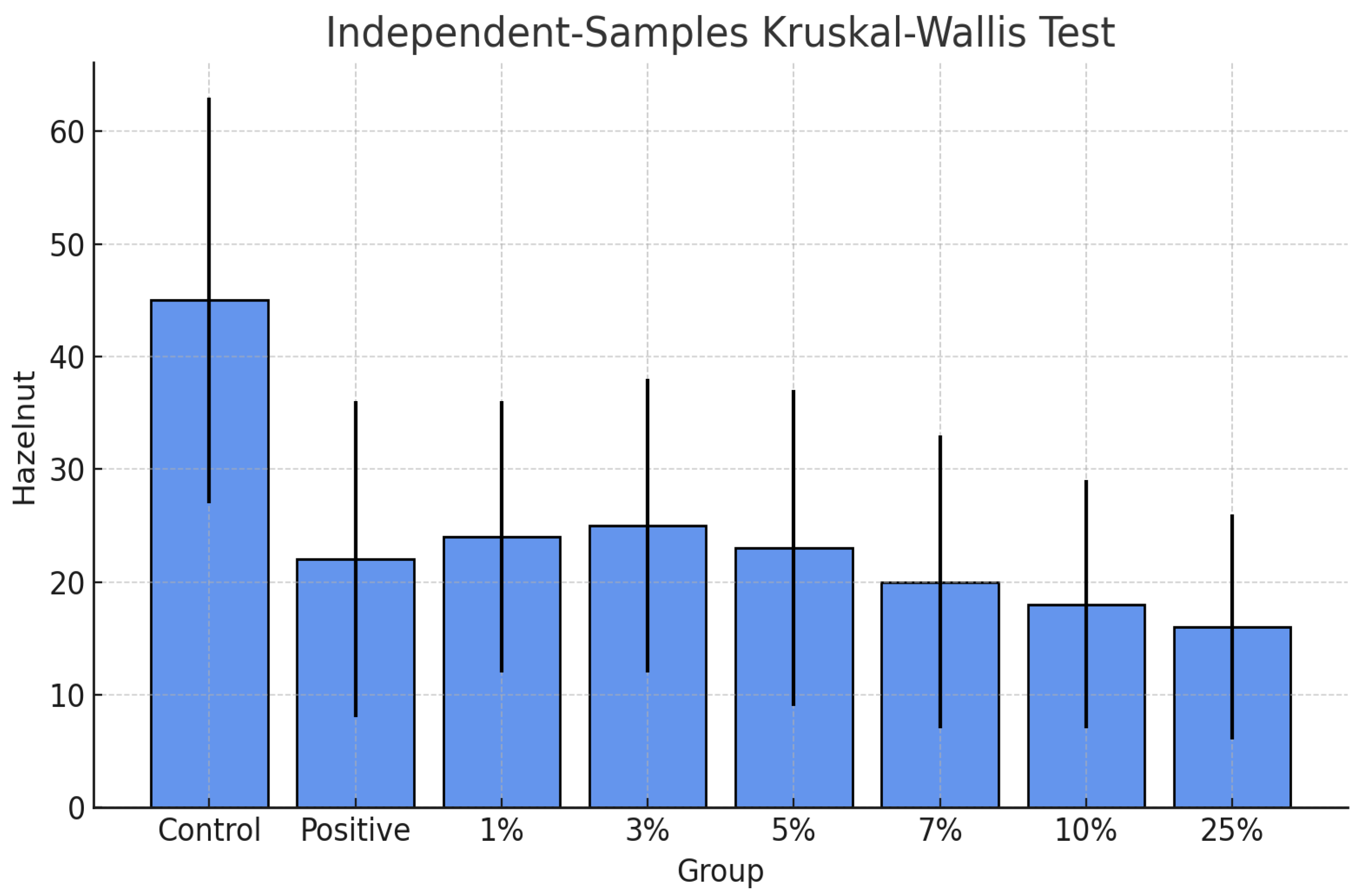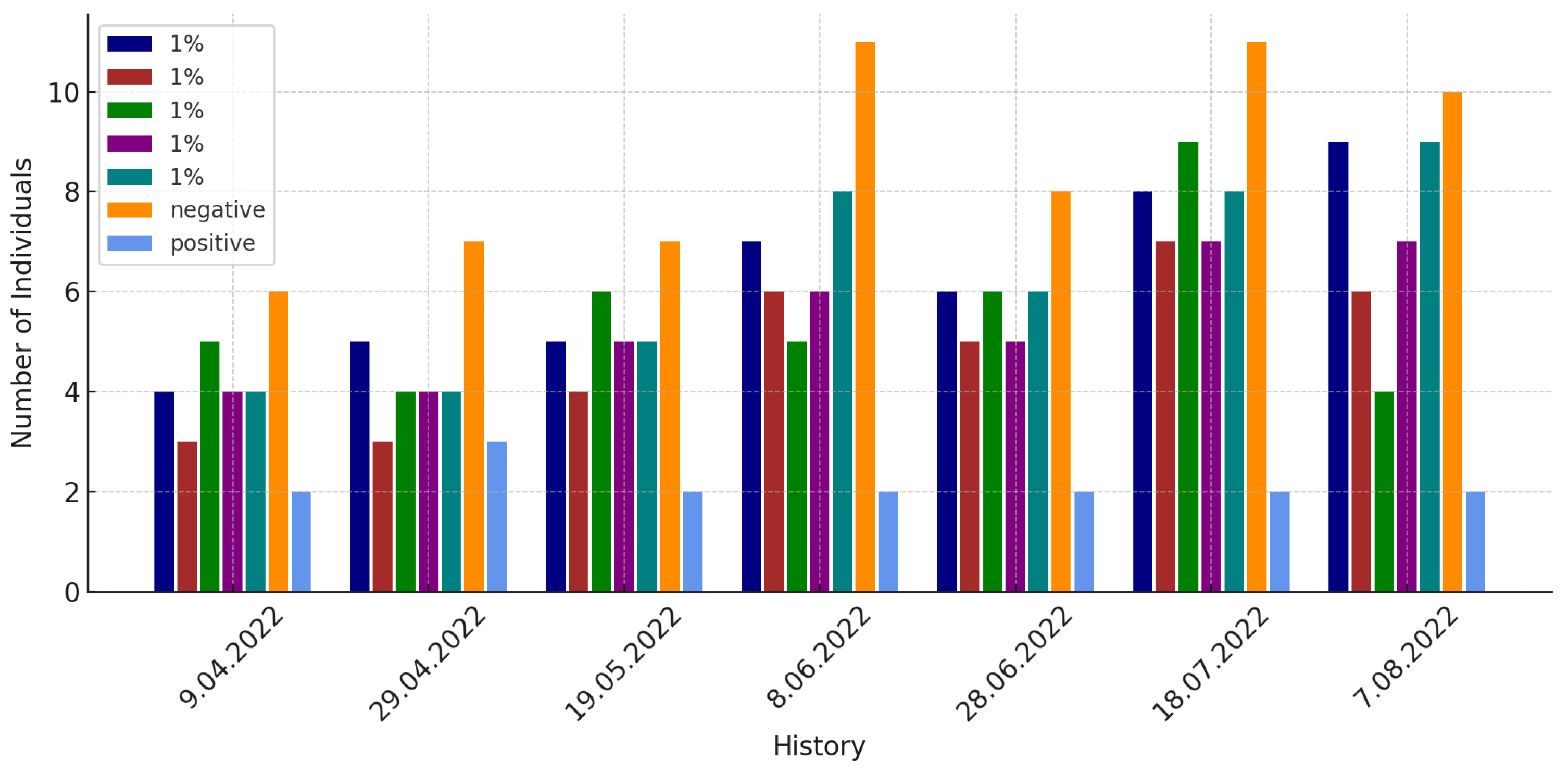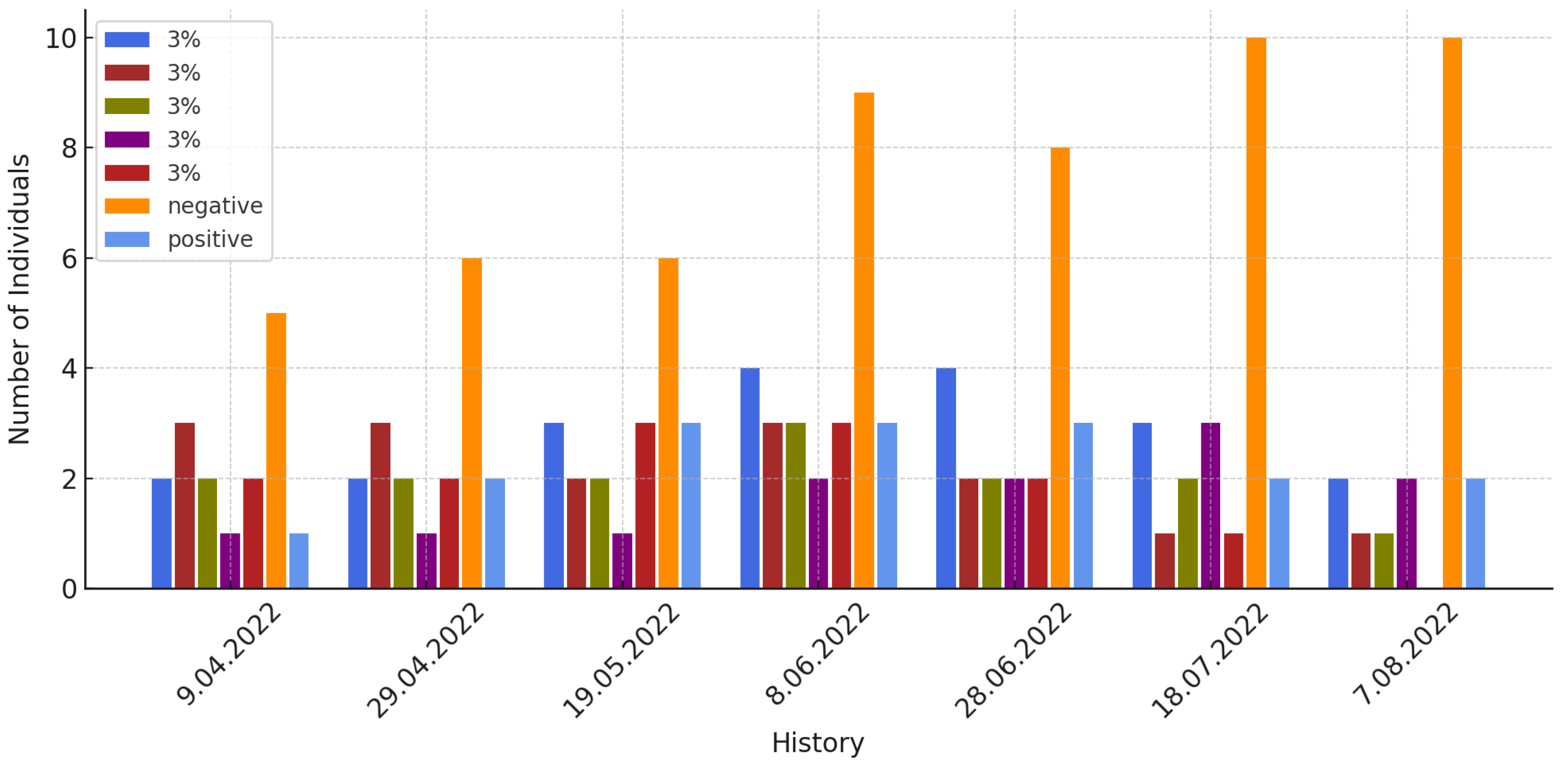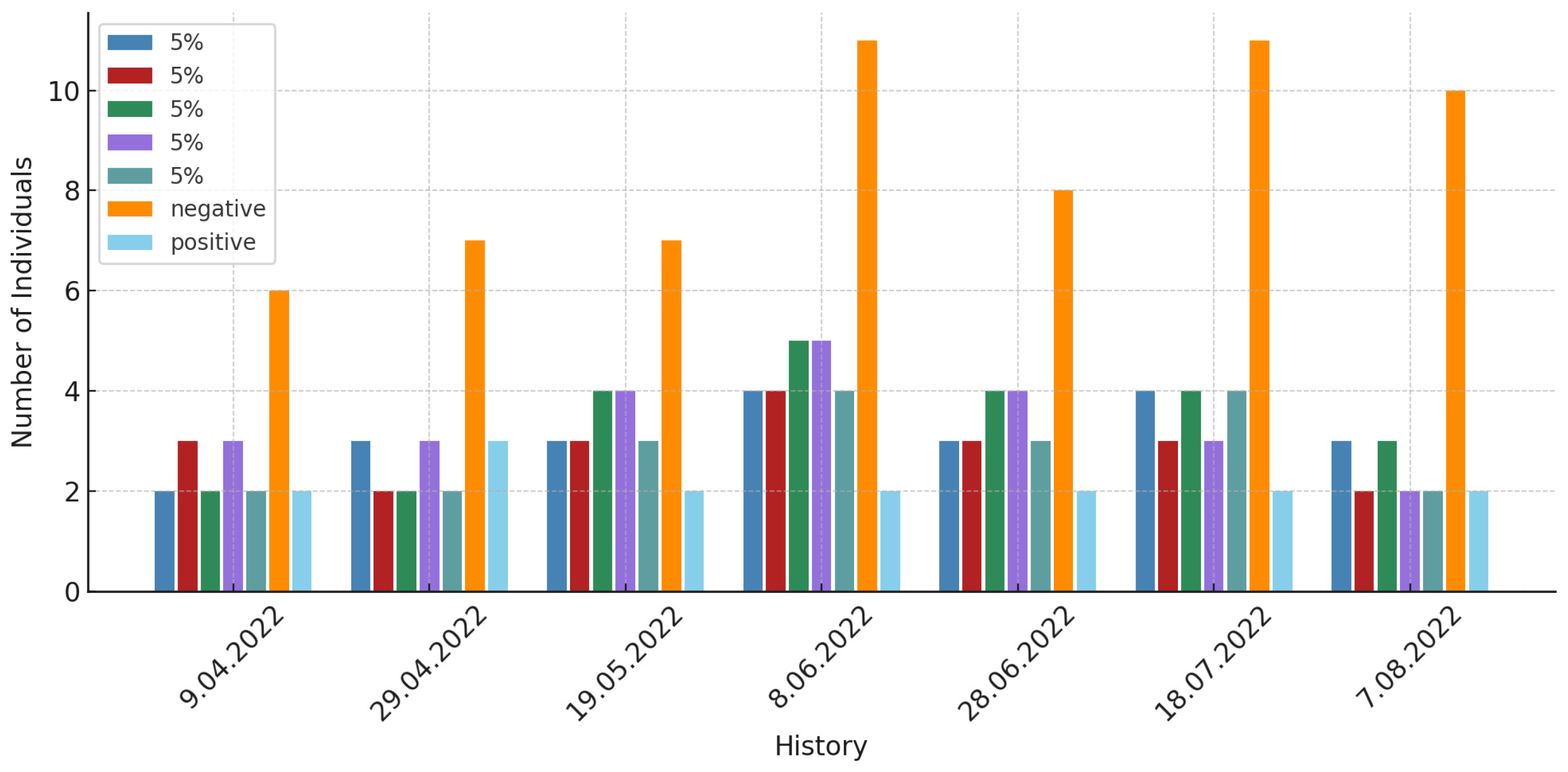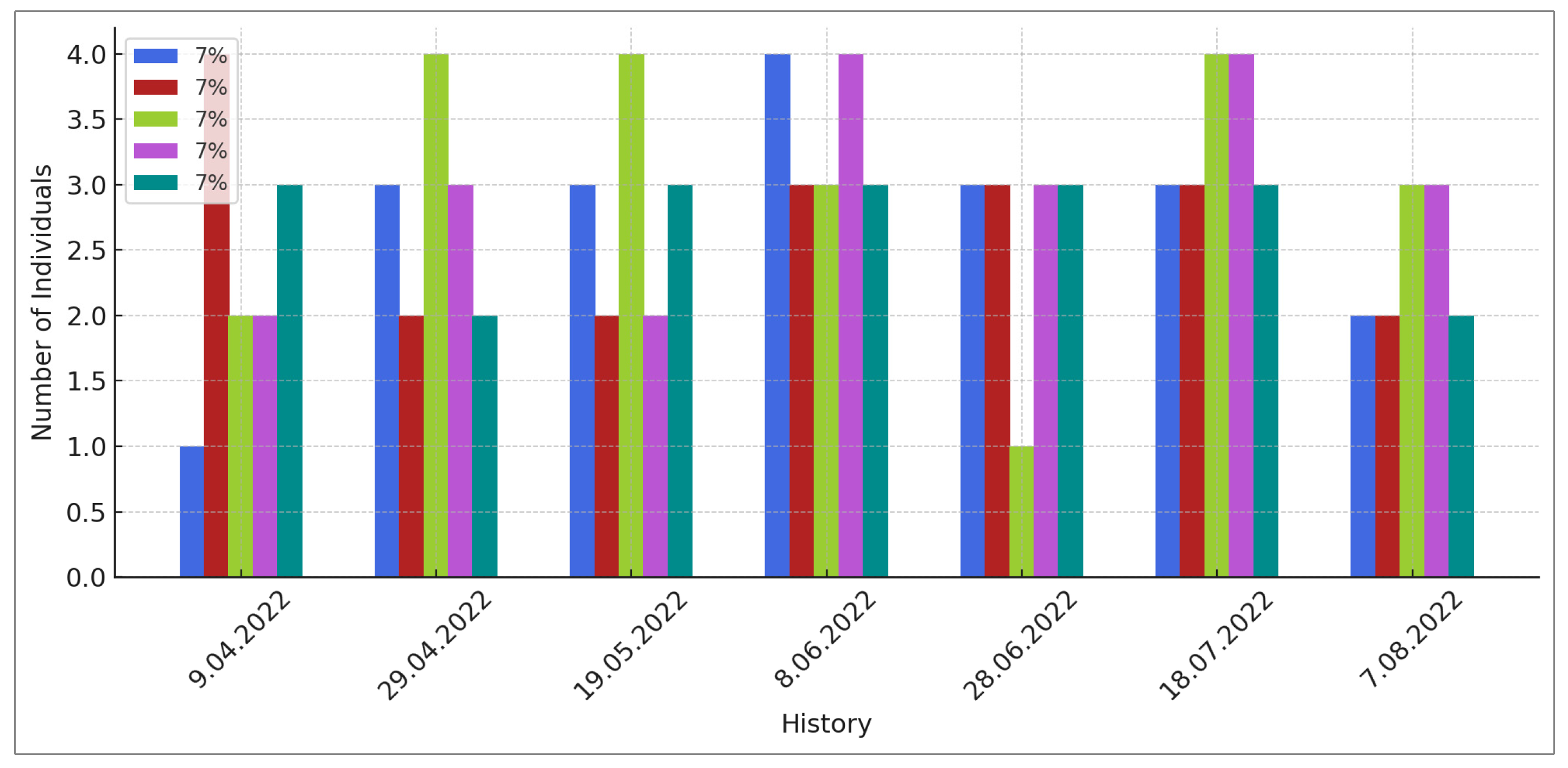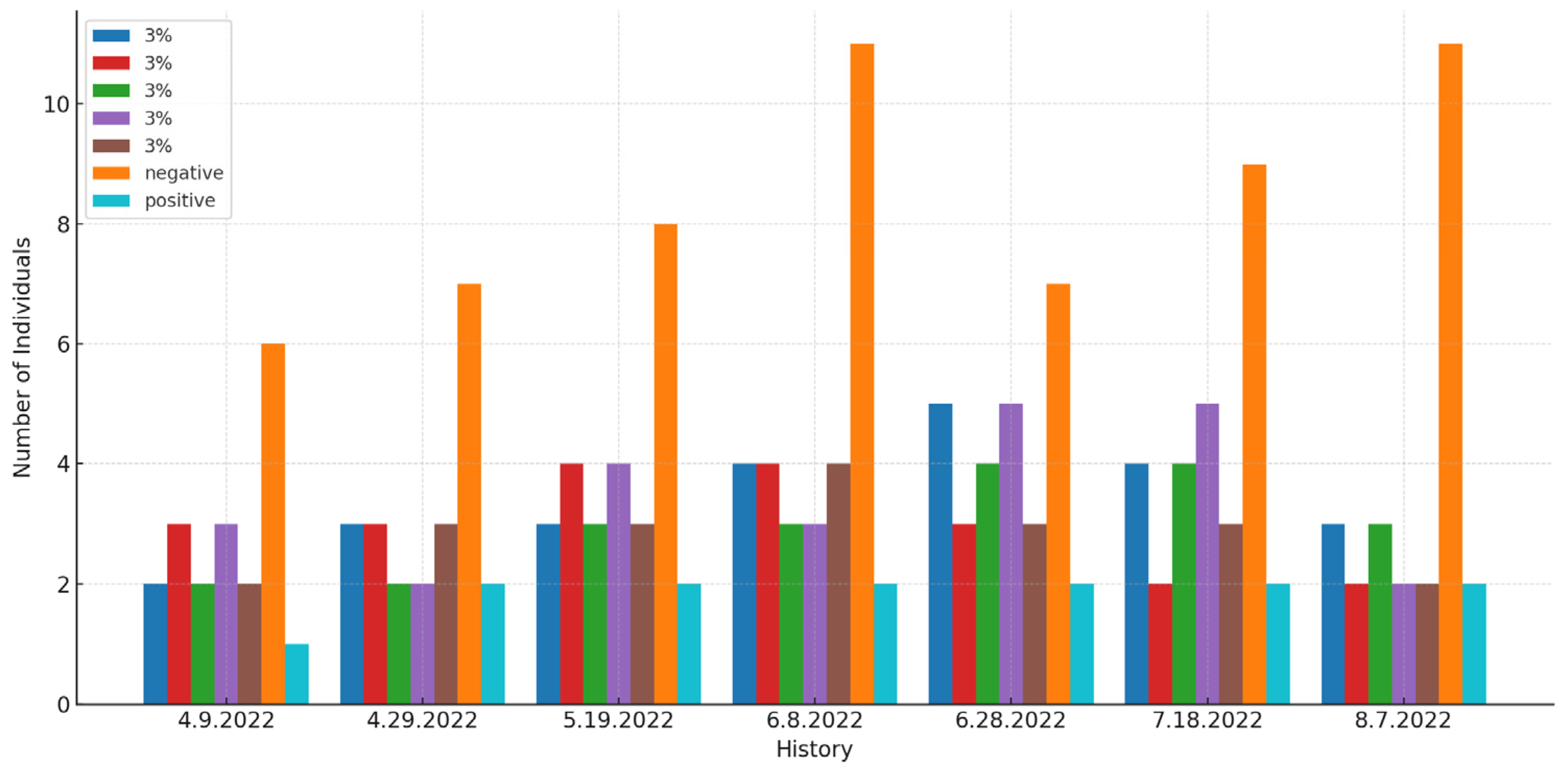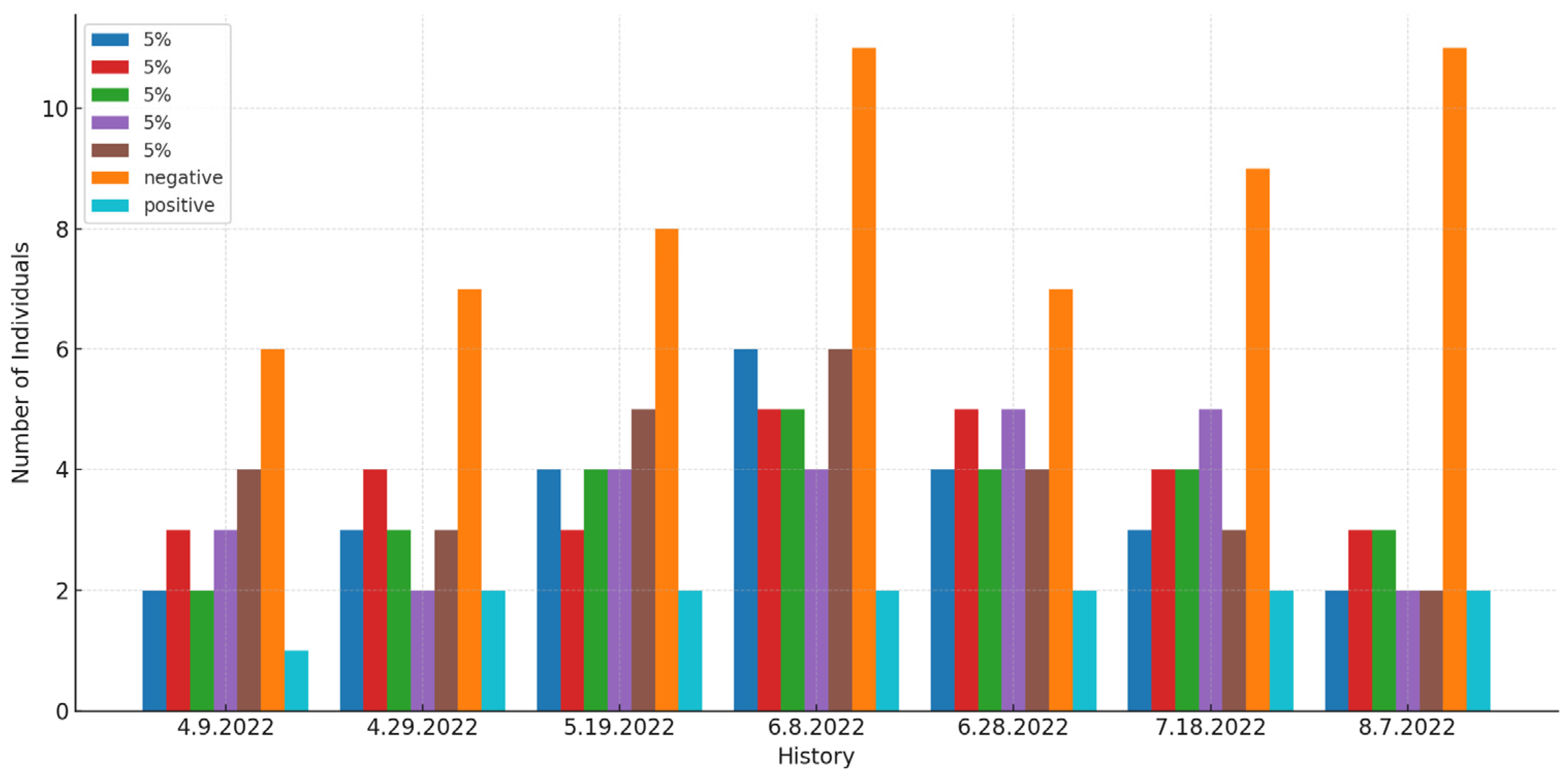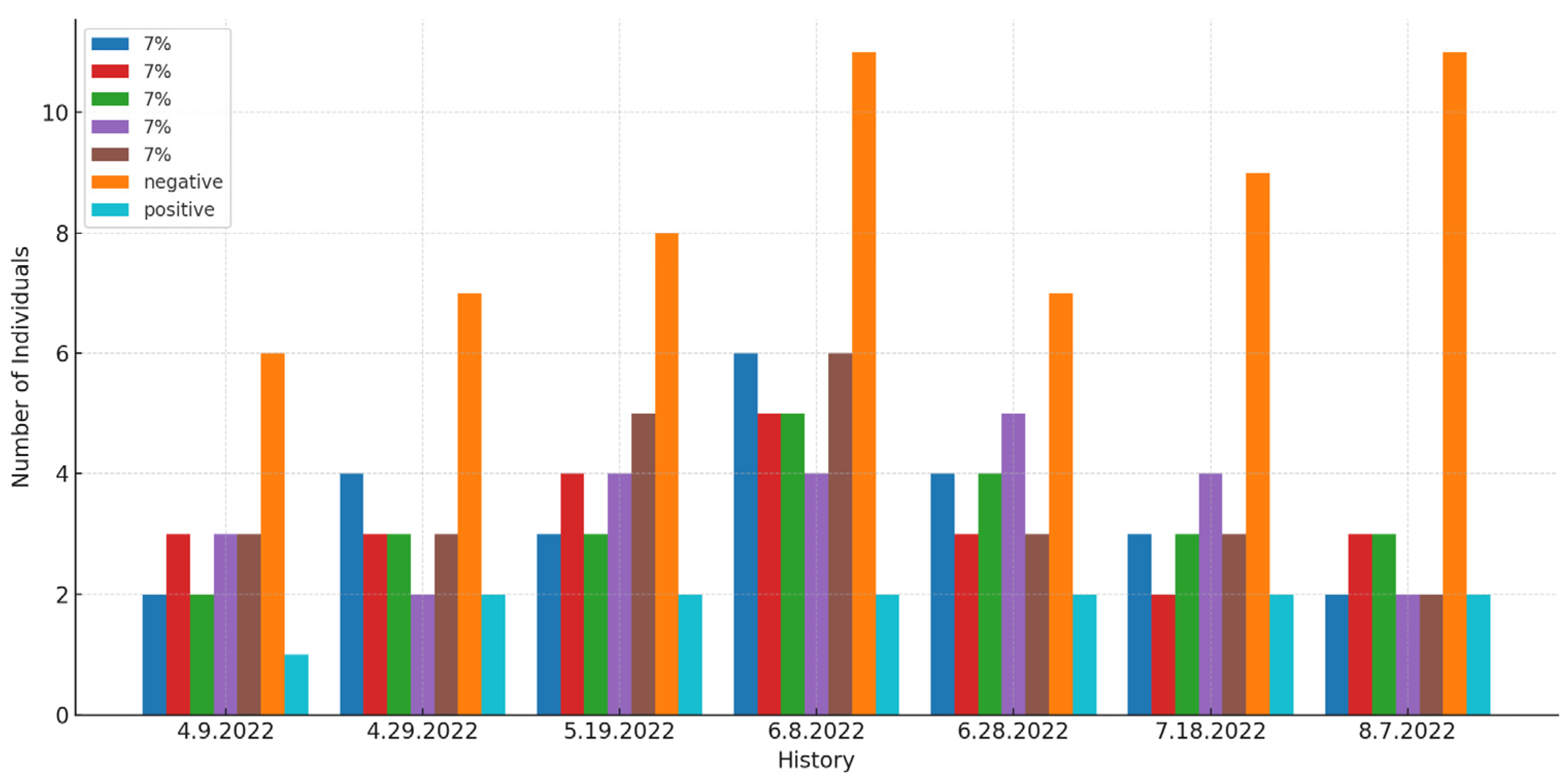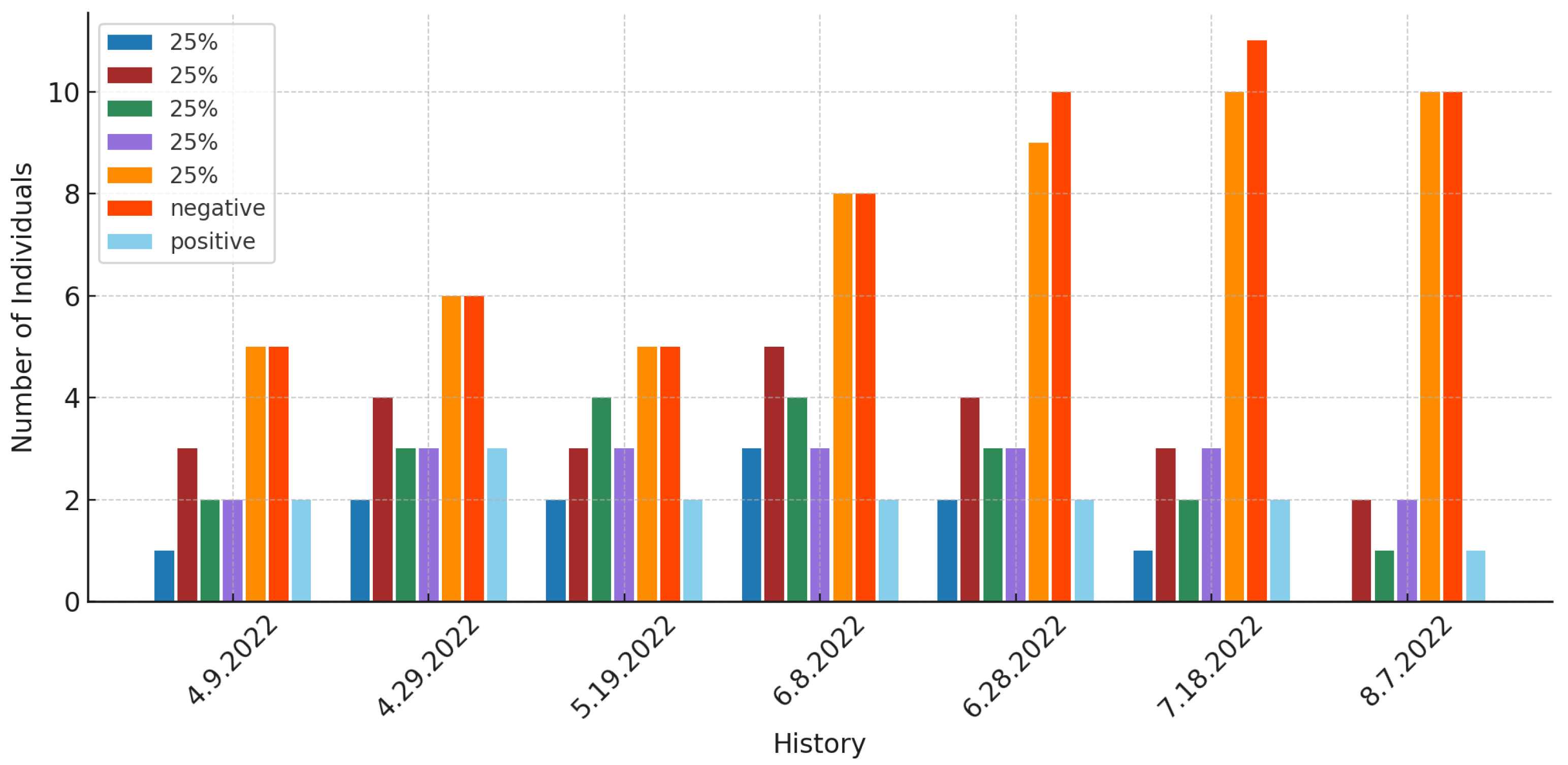1. Introduction
The goal of agriculture is not only to achieve high crop yields per unit area, but also to cultivate products that are compatible with sustainable agricultural practices and considerate of animals, humans, and the environment. To accomplish this, proper soil management, fertilization, pruning, and the use of healthy and productive saplings, seedlings, and seeds are essential. Diseases, pests, and weeds can cause substantial losses in both the quality and quantity of agricultural products [
1]. To mitigate these effects, various techniques have been developed, tailored to different groups of organisms responsible for such losses. These measures include cultural practices, physical–mechanical control, chemical control, biological control, biotechnical control, and integrated control. However, among these, chemical control has become the most widely used method due to its ease of application and rapid results [
1,
2].
Planococcus ficus (
P. ficus) causes damage to the trunk, shoots, and clusters.
Planococcus ficus (vine mealybug) is a pest that adversely affects both the yield and quality of grapevines. By sucking plant sap, it weakens the vine and may eventually cause dieback. The honeydew secreted by the mealybug creates a favorable environment for fungal growth, while the resulting sooty mold inhibits photosynthesis. Sooty mold inhibits respiration and photosynthesis, reduces product quality, and can ultimately cause the plant to dry out completely [
1,
2,
3]. The mealybug belongs to the superfamily Coccoidea (order Hemiptera). The Coccoidea represent a remarkable group due to their distinct morphological and biological characteristics. There is a growing body of literature investigating the effects of wood vinegar, hazelnut vinegar, and similar natural products on agricultural pests. For instance, Iacomino et al. (2024) [
4] evaluated the chemical composition of wood vinegar and its biological effects on pests such as the olive fruit fly (
Bactrocera oleae) and the root-knot nematode (
Meloidogyne incognita), reporting that it exhibited a measurable degree of efficacy under both greenhouse and field conditions. However, unlike the present study, their work did not specifically target vineyard pests and did not report suppressive effects exceeding 70%. Similarly, a study conducted in Diyarbakır and Elazığ examined the insecticidal effects of wood vinegar on the almond leaf bee (
Cimbex quadrimaculata), demonstrating that various concentrations were effective under field conditions [
5]. While this study shares certain similarities with the current research, the present work is more comprehensive, as it evaluates both wood and hazelnut vinegars simultaneously and assesses not only their toxicological but also their repellent effects against
Planococcus ficus.
In addition, a study published in
Maderas (2022) investigated the antifungal and larvicidal properties of wood vinegar against wood-degrading fungal species and insect larvae, reporting eco-friendly protective effects at low and moderate concentrations. Nevertheless, this work primarily focused on wood material preservation and did not address applications in vineyard settings [
6]. Liu et al. (2020) [
7] conducted a comprehensive review summarizing the effects of wood vinegar on bacteria, fungi, viruses, nematodes, harmful arthropods, and weeds, while also discussing its mechanisms of action and advantages. However, the majority of the data presented in that review were derived from laboratory or greenhouse conditions.
Therefore, the present study distinguishes itself in the literature by demonstrating strong suppressive effects against Planococcus ficus under vineyard field conditions, simultaneously testing different types of vinegar (wood and hazelnut), and additionally evaluating their impacts on beneficial insects.
Othman et al. (2023) [
8] investigated the effects of wood vinegar on the rice weevil (
Sitophilus oryzae), a major pest of stored rice products, by applying different concentrations (50–200 ppm) and evaluating its repellency, mortality, and antifeedant properties. This study is similar to the present research in highlighting the potential of natural products for insect control. However, it was conducted under laboratory and storage conditions, which differs from the field-based applications in vineyards reported here. The present study therefore provides greater practical relevance by demonstrating pest suppression under real production conditions [
8]. The study by Liu et al. (2020) [
7] provides a comprehensive review evaluating wood vinegar derived from various raw materials and summarizing its effects on bacteria, fungi, viruses, nematodes, insects, and weeds. In terms of similarity, both studies emphasize the potential of wood vinegar as an alternative within integrated pest management (IPM) strategies. The main distinction is that Liu et al.’s work is a review, whereas the present research presents original field data. Therefore, our study makes a more direct contribution to the literature in terms of practical applications [
7]. Akkuş et al. (2022) [
6] investigated the effects of oak wood vinegar at different concentrations (1–6%) on fungal species and old house borer larvae (
Hylotrupes bajulus), demonstrating both antifungal and larvicidal activities. Their study supports the potential of wood vinegar as a biopesticide. However, since it primarily focused on wood preservation and material durability, it is not directly relevant to vineyard pests. In contrast, the present study targets a pest that causes direct economic losses in agricultural production and evaluates its control under field conditions, thereby providing broader agricultural benefits [
6]. Similarly, studies investigating the inhibitory effects of wood vinegar on fungal species such as
Alternaria panax and
Botrytis cinerea have reported strong antifungal activity even at low and moderate concentrations. These studies underscore the potential of natural products in protecting plant health. However, their focus is on plant pathogenic fungi rather than insect pests, and they do not provide field-based data on pest suppression as presented in the current research. In this context, our study offers a novel and complementary contribution to the literature by demonstrating strong suppressive effects on insect pests under field conditions [
9].
Chenari Bouket et al. (2023) reported that semi-volatile organic compounds (Semi-VOCs) from wood vinegar exhibit strong antifungal activity against oomycete species
Globisporangium ultimum and
Pythium aphanidermatum, thereby reinforcing the notion that wood vinegar contains biologically active components with potential for phytopathogen control, which could synergize with or replace synthetic fungicides [
10]. Similarly, Mansour et al. (2023) [
11] evaluated the toxicity of pesticides used in European vineyards on beneficial parasitoids
Anagyrus vladimiri and
Trichogramma evanescens, natural enemies of
Planococcus ficus and
Lobesia botrana. Their findings highlight the collateral damage that synthetic pesticide regimes can impose on beneficial insects. In contrast, our results demonstrate that wood and hazelnut vinegars alone—without pesticide addition—achieved high suppression (>70%) of
P. ficus populations, whereas Mansour et al. focused on pesticide effects on non-target parasitoids rather than evaluating natural product alternatives [
12]. Overall, the similarity among these studies lies in their shared emphasis on reducing synthetic inputs and protecting non-target organisms. The key distinction is that the present study specifically demonstrates strong pest control efficacy using vinegars alone under field vineyard conditions, whereas the referenced studies focus primarily on antifungal activity [
13] or assess the toxicity of synthetic pesticides on beneficial organisms [
14].
Kim et al. (2008) [
15] demonstrated that the application of wood vinegar in combination with synthetic pesticides increased the mortality rate of
Nilaparvata lugens by approximately 42%. While notable, this effect was dependent on the synergistic action of pesticides. In contrast, the present study achieved a pest population reduction of over 70% using wood and hazelnut vinegars alone, without any pesticide additives. This highlights the potential of these natural biopesticides to serve as standalone alternatives, eliminating the need for synthetic inputs and providing a more sustainable and environmentally responsible pest control strategy [
15]. Hagner (2013) [
16] reported a 68% reduction in vineyard pest populations through the application of 20% wood vinegar under field conditions, confirming the efficacy of wood vinegar in viticultural pest management. However, the present study not only corroborated but slightly exceeded this level of effectiveness, achieving pest reductions of approximately 70–71% at 25% concentrations. Moreover, the research clearly defined the target species (
Planococcus ficus) and incorporated hazelnut vinegar as a novel input, thereby offering a more precise and innovative contribution to the biopesticide literature [
16].
Cai et al. (2012) [
17] evaluated the toxicological effects of wood vinegar on the model organism
Caenorhabditis elegans, reporting mortality rates of 60–75% under oxidative stress conditions. While valuable for understanding broad-spectrum toxicity, the laboratory-based nature of their study limits its direct applicability to field conditions. In contrast, the present field-based study demonstrated a comparable mortality rate against
P. ficus in vineyard environments, thereby validating the real-world applicability of wood and hazelnut vinegars as bioactive agents within integrated pest management (IPM) programs [
17]. Ferreira et al. (2013) [
18] investigated the insecticidal properties of sugarcane-derived pyroligneous acid against
Spodoptera frugiperda, reporting effective larval control, although without specific quantitative outcomes. In comparison, the present study employed similar pyrolytic by-products—wood and hazelnut vinegars—but provided detailed statistical evidence and dose-specific efficacy, achieving pest reductions exceeding 70%. This enhances the replicability and practical relevance of our findings for researchers and practitioners in organic and sustainable agriculture [
18]. Jothityangkoon et al. (2008) [
19] reported a 50% reduction in aflatoxin contamination caused by
Aspergillus spp. in peanuts through wood vinegar applications. Although the target organisms in their study were fungi rather than insects, their findings confirmed the broad-spectrum antimicrobial properties of wood vinegar. The present study extends this knowledge by demonstrating that the same compound, when derived from agricultural waste, exhibits potent insecticidal effects as well—achieving over 70% reduction in
P. ficus populations—thereby reinforcing the multifunctional role of pyroligneous extracts in agricultural pest management [
19]. Taş et al. (2022) [
20] emphasized the role of organic fertilizers on strawberry yield parameters and soil nematode trophic structures, highlighting the importance of sustainable agricultural inputs. While their study focused on plant nutrition and soil health, the present research complements this perspective by addressing pest management through the use of natural by-products. By employing wood and hazelnut vinegars as biopesticides, the study contributes to the same overarching goal of promoting environmentally friendly and ecologically balanced farming systems [
20]. Koç et al. (2024) [
5] applied wood vinegar at varying concentrations (1–25%) against
Cimbex quadrimaculata, reporting effectiveness rates between 45% and 72%. Similarly, the present study implemented the same concentration ranges against
Planococcus ficus, achieving comparable levels of pest suppression. What distinguishes the present work, however, is the inclusion of hazelnut vinegar—a rarely studied biopesticide—providing new insights into its efficacy. Furthermore, the application of these treatments in vineyard ecosystems against a specifically identified pest enhances both the practical relevance and scientific novelty of our findings [
5].
Pesticides are among the primary contributors to soil pollution [
21]. Soil, which provides a suitable environment for the survival of humans and other living organisms, must be protected and sustainably managed [
22]. The world population is projected to reach 9.8 billion by 2050 [
23], and this population growth is the main driver for the increased demand in agricultural production [
24].
With the increase in population, environmental pollution and the rising consumption of resources may adversely affect the conditions necessary for the survival of living organisms worldwide [
24]. It is recognized that pesticide use has become more regulated globally following environmental protection movements; some pesticides have undergone control testing, while others have been banned or restricted based on these assessments [
25]. For instance, Denmark and France have successfully reduced pesticide usage by 50% through policy decisions [
26]. In line with these efforts, the European Union has developed strategies to mitigate environmental pollution, regulate pesticide use, and reduce the negative impacts of these chemicals, with the European Parliament formally adopting this strategic directive [
27].
The Ministry of Food, Agriculture and Livestock anticipates a reduction in pesticide usage in accordance with strategies established for the control of pests and diseases [
28]. Due to the adverse effects associated with intensive pesticide use, the development of alternative pest management methods has become increasingly necessary [
29]. Biopesticides derived from natural sources can originate from a variety of organisms, including bacteria, animals, and plants [
30]. In recent years, research on the effects of naturally produced organic pesticide formulations on beneficial organisms has expanded rapidly [
31]. Plant-based products play a significant role in influencing pesticide interactions with soil [
32]. Furthermore, new technologies and organic matter have been integrated into the production of organic pesticides. For instance, organic pesticides have been tested under greenhouse and field conditions against lepidopteran pests in Far Eastern countries, providing effective pest control and enhancing tomato yields [
33].
Parviflora stem and root extracts have demonstrated strong lethality in trials against
Nemodotlar [
34]. Wood vinegar (WV), a natural biopesticide, represents an alternative to chemical control of WB [
35]. WV, obtained as a by-product of charcoal production, results from the carbonization process [
36]. Kim et al. reported that the annual production of WV is approximately 15,000 tons [
15]. Jothityangkoon et al. indicated that WV primarily consists of acetic acid, along with 10–20% of more than 200 organic compounds and 80–90% water, and is applied in agricultural fields as an organic fungicide, fertilizer, and insect repellent [
37]. Although limited information exists regarding the toxic effects of WV [
32], it has been reported to have positive effects on soil [
38]. Consequently, wood vinegar is considered an effective natural pesticide for sustainable agriculture and organic farming, and it is widely used in agricultural practices in Far Eastern countries [
39]. In addition to the general limitations associated with synthetic chemical pesticides, the present study specifically focused on wood vinegar (WV) and hazelnut vinegar (HV) for several reasons. WV is a well-documented pyrolysis by-product, widely recognized for its insecticidal, antifungal, and repellent properties in agricultural systems. In contrast, HV remains an underexplored biopesticide, derived from locally abundant agricultural waste, offering both novelty and sustainability benefits. By including both WV (a validated biopesticide) and HV (a novel natural extract), this study provides both confirmatory and innovative contributions to integrated pest management research. In this study, vinegar dosage levels were determined based on prior research, with concentrations ranging from 10% to 25%. These levels were established through preliminary trials and informed by previous studies on major pests (Koç et al., 2024 [
5]). Specifically, earlier research involving
Cimbex quadrimaculata and certain nematode groups identified effective concentrations, which guided the selection of dosages in the present study (Koç et al., 2024 [
5]; Taş et al., 2022 [
20]). The comparison of Wood and Hazelnut Vinegar against
Planococcus ficus is as follows (
Table 1).
The aim of this study is to develop a novel, environmentally friendly approach for the control of Planococcus ficus, a significant agricultural pest. In accordance with sustainable pest management principles and ecological harmony, the study seeks to promote alternatives to synthetic pesticides through the use of organic by-products. Specifically, it focuses on the application of wood and hazelnut shell vinegars, obtained via high-temperature pyrolysis of agricultural waste materials. These by-products, which are typically considered environmental pollutants, are repurposed as potential bioactive agents for pest control, aligning the study with broader environmental sustainability goals.
2. Materials and Methods
The methodology involved the preparation of wood vinegars (WV) using a cost-effective, farmer-applicable pyrolysis technique designed to preserve key bioactive compounds. Field applications of different concentrations were carried out in infested orchards, and pest populations were monitored over time using visual inspection and physical sampling methods. Repellency and mortality data were collected at regular intervals, while the effects on non-target organisms were also recorded. Statistical analyses, including the Kruskal–Wallis test, were employed to evaluate treatment efficacy and to determine significant differences among application doses. The findings were interpreted in the context of their practical applicability and contribution to sustainable, low-impact pest management strategies. The main materials used in the study included wood vinegar (WV) and hazelnut vinegar (HV) obtained from the pyrolysis system, vineyard areas infested with P. ficus, atomizers, culture boxes, and other necessary equipment and materials.
IBM SPSS Statistics software was used for the statistical evaluation of the data throughout the study. All data were analyzed using licensed statistical software available at Fırat University (Elazığ, Türkiye), primarily IBM SPSS Statistics version 21 (IBM Corp., Armonk, NY, USA). n this study, a Double Condensation PID-Controlled Pyrolysis System was used. The brand of the Double Condensation PID-Controlled Pyrolysis System device is ELKIMAK. These devices are commonly employed for the production of wood vinegar, hazelnut shell vinegar, and other types of bio-vinegars. They are capable of operating at very high temperatures. A new-generation pyrolysis system was employed, designed to thermochemically convert biomass waste materials into valuable liquid products. Specifically, wood vinegar was obtained from wood bark waste and hazelnut vinegar from hazelnut shell waste through high-temperature pyrolysis. The pyrolysis experiments and subsequent liquid product analyses were carried out at Fırat University (Elazığ, Türkiye). The system consisted of a computer-controlled heating reactor with a maximum temperature capacity of 600 °C. The pyrolysis process was terminated at 385 °C, the temperature at which the highest liquid yield was achieved. The temperature control and monitoring system included digitally calibrated thermocouple sensors interfaced with a data acquisition system to ensure process stability and precise thermal regulation throughout the reaction.
2.1. Production of Wood and Hazelnut Vinegar
In this study, an experimental pyrolysis process was conducted to obtain valuable liquid products from wood bark waste and hazelnut shells. The study aimed to reduce environmental impacts and convert waste biomass into value-added products, utilizing a PID-controlled pyrolysis reactor system. The system could reach a maximum temperature of 600 °C with a constant heating rate of 10 °C per minute from room temperature. During the experimental procedure, the pyrolysis process was terminated at 385 °C, at which temperature the liquid product yield reached its maximum. Wood bark waste underwent thermal decomposition at high temperatures, resulting in the separation of products into solid, liquid, and gaseous phases. This study focused specifically on the liquid fraction, and the physical properties of the resulting liquid product were evaluated. The hazelnut vinegar used during the process contributed to the pyrolytic reaction environment and played a role in enhanced the properties of the final product. The reactor system was equipped with a high-precision PID controller to ensure stable heating within the target temperature range. An inert medium (nitrogen gas) was used during the pyrolysis process, allowing degradation to occur under anaerobic conditions. The resulting liquid product was collected for further analysis to evaluate its potential pesticidal or antimicrobial activity. This study is significant for assessing waste lignocellulosic materials, developing sustainable production approaches, and producing biofunctional liquids with natural components active against harmful organisms. Furthermore, the reactor system and experimental parameters (temperature, time, and biomass quantity) provide a framework for future research on the conversion of various biomass types using similar methodologies. The optimum biomass input for the PID reactor was determined to be 2 kg, and the biomass was ground to a particle size of 50/100 mesh to increase surface area and enhance pyrolysis efficiency. The internal volume of the PID reactor was 8 L, allowing this biomass load to be processed effectively. Biological treatment or microbial preconditioning was performed either before or after the pyrolysis process. The pyrolysis reaction was terminated at 385 °C, the temperature at which wood vinegar (pyrolysis liquid) formation was maximized. These liquids typically contain acetic acid, phenolic compounds, and various volatile organic substances. The fermentation period was set to 3–7 days, with incubation conditions of 30–37 °C and a pH range of 5.5–6.5. Bacterial species identified during fermentation included
Acetobacter aceti,
Bacillus subtilis,
Pseudomonas putida, and
Clostridium spp. To remove toxic compounds from the pyrolysis liquid, distillation and filtration were applied. Wood and hazelnut biomass blocks were used as raw materials, with 2 kg (2000 g) of biomass suspended in 8–10 L of water depending on the experiment, corresponding to a mass concentration of 200–250 g/L. The application amounts according to the doses are presented in
Table 2. The concentration levels used in
Table 2 (1–25%) were determined based on preliminary pot trials and previous research (Koç et al., 2024 [
5]; Taş et al., 2022 [
20]). These studies indicated that 10% and 25% represent effective threshold values. Intermediate concentrations, such as 17.5%, were omitted to facilitate field applications and to reduce resource constraints. While testing intermediate concentrations could provide additional insights into dose-response relationships, the current data clearly demonstrate a significant pest-reducing effect at both 10% and 25% concentrations. This study was supported by the Fırat University Scientific Research Project, which has been completed. The number of the Master’s Thesis Research Project supported by this grant is MMY.21.04.
2.2. Application of Wood and Hazelnut Vinegar in the Field
Preliminary pot trials demonstrated a repellent effect of both wood and hazelnut vinegars against
Planococcus ficus, which were subsequently pre-tested under farmer field conditions in Hoş Village (Elazığ Province) over two consecutive years (
Table 3). These pre-applications facilitated the determination of appropriate treatment doses (1%, 3%, 5%, 7%, 10%, and 25%) and optimized the timing of field applications. A total of 140 sample plants, covering an area of 3500 m
2, were monitored. Prior to application, larval counts on the trunk and green tissues were recorded, followed by weekly post-treatment assessments. All bioassays were conducted under controlled climate chamber conditions at a constant temperature of 25 °C, 65% relative humidity, and a 16:8 h light/dark photoperiod. Although direct tests on beneficial insects were not performed, field observations revealed minimal adverse effects on Coccinellidae populations, thereby supporting the ecological selectivity of the tested vinegars.
In the study, wood and hazelnut vinegars were applied at the beginning of leaf formation, with each dose tested on five vines. For both application periods, a total of 120 vines were treated (60 per period), in addition to 10 vines that served as negative controls, resulting in 130 vines in total. Furthermore, a licensed pesticide was applied to 10 vines as a positive control.
For the application of treatments, a back sprayer (Hyundai Turbo 300 Gasoline Atomizer, 14 L capacity, blown sprayer type HIM) was used to ensure uniform distribution of the solutions onto the infested plants. Working doses were prepared by diluting the pyrolysis liquid in 20 L of distilled water to obtain concentrations of 1%, 3%, 5%, 7%, 10%, and 25% (v/v). Accordingly, 200 mL, 600 mL, 1000 mL, 1400 mL, 2000 mL, and 5000 mL of pyrolysis liquid were added to the respective solutions. These prepared treatments were applied to P. ficus-infested vineyards during both the early and late foliation periods using the back sprayer, and their insecticidal and repellent effects were subsequently evaluated.
During the field trials, malathion was used as the sole positive control due to limited resource availability. However, future studies are planned to incorporate commonly used biopesticides, such as neem extract and Bacillus thuringiensis formulations, as additional positive controls to allow for a more comprehensive comparison of treatment efficacy.
2.3. Determination of the Effects of Vinegar Material Used on Natural Enemies
To assess the non-target effects of wood and hazelnut vinegars, weekly surveys of predatory insects belonging to the family Coccinellidae were conducted following the treatments. Two complementary methods were employed: direct visual inspection and the Japanese umbrella technique. The Japanese umbrella was constructed with a square frame of 40 × 40 cm, designed to cover the average vine canopy projection, with a collection jar placed at the bottom to capture dislodged insects. After identification and enumeration, all individuals were released back into the field. The obtained numerical data were subsequently processed and represented graphically.
2.4. Data Analysis Method
The Mann–Whitney U test is a non-parametric statistical method used to compare the central tendency of two independent groups when the data do not meet the assumptions of normality. The Kruskal–Wallis test is a non-parametric technique employed to assess whether there are statistically significant differences among three or more independent groups under non-normal distribution conditions. It is considered the non-parametric alternative to the one-way ANOVA.
3. Results
The results for
Planococcus ficus are presented in
Table 4, based on larval counts recorded on the pest’s body and leaves. A statistically significant difference was observed among the treatment groups for both wood vinegar and hazelnut vinegar (
p < 0.05). For wood vinegar, significant differences were found between the control and all treatment groups. For hazelnut vinegar, significant differences were detected between the control and all concentrations except 1%; additionally, the 25% treatment differed significantly from the 1%, 3%, and 5% concentrations. The outcomes of the Kruskal–Wallis analysis for wood and hazelnut vinegars are illustrated in
Figure 1 and
Figure 2.
In
Figure 1, the 25% concentration differed significantly from the 1%, 3%, and 5% concentrations. Similarly, In
Figure 2, a significant difference was observed between the 25% treatment and the 1%, 3%, and 5% treatments. The Mann–Whitney U test results, presented in
Table 5, were used to compare the effects of wood and hazelnut vinegars at equivalent concentrations. No statistically significant differences were detected between the wood and hazelnut groups across the tested concentrations (
p > 0.05).
The weekly effects of wood and hazelnut vinegars applied at concentrations of 1, 3, 5, 7, 10 and 25% on total Coccinellidae family species are shown in
Figure 3,
Figure 4,
Figure 5,
Figure 6,
Figure 7,
Figure 8,
Figure 9,
Figure 10,
Figure 11,
Figure 12,
Figure 13 and
Figure 14.
The effect of 3% wood vinegar application on the total number of Coccinellidae was evident throughout the study. While an increase in Coccinellidae numbers was generally observed in response to rising
P. ficus populations on counting days for both wood and hazelnut vinegar treatments, the total number of Coccinellidae decreased in all 3% wood and hazelnut vinegar applications compared to the negative controls (
Figure 4).
The 5% wood vinegar application had a measurable impact on Coccinellidae populations. While their numbers increased in response to elevated
P. ficus populations during observation days, all treatments involving 5% wood and hazelnut vinegar resulted in a reduction in total Coccinellidae numbers compared to negative controls (
Figure 5).
The effect of 7% wood vinegar application on the total number of Coccinellidae was clearly evident throughout the study. Although Coccinellidae populations increased in response to higher
P. ficus densities on the counting days for both wood and hazelnut vinegar treatments, all 7% applications led to a reduction in the total number of Coccinellidae compared to the negative controls (
Figure 6).The effect of 10% wood vinegar application on the total number of Coccinellidae was clearly observed throughout the study. Although the total number of Coccinellidae increased in response to higher
P. ficus populations on the counting days for both wood and hazelnut vinegar treatments, all 10% applications resulted in a decrease in the total number of Coccinellidae compared to the negative controls (
Figure 7).The effect of 25% wood vinegar application on the total number of Coccinellidae was distinctly observed during the study. Although Coccinellidae numbers increased in response to higher
P. ficus populations on the counting days for both wood and hazelnut vinegar treatments, all 25% applications led to a decrease in the total number of Coccinellidae compared to the negative controls (
Figure 8).
The effect of 1% hazelnut vinegar application on the total number of Coccinellidae was clearly observed throughout the study. Although the total number of Coccinellidae increased in response to higher
P. ficus populations on the counting days for both wood and hazelnut vinegar treatments, all 1% applications resulted in a decrease in the total number of Coccinellidae compared to the negative controls (
Figure 9).
The effect of 3% hazelnut vinegar application on the total number of Coccinellidae was clearly observed throughout the study. Although the total number of Coccinellidae increased in response to higher
P. ficus populations on the counting days for both wood and hazelnut vinegar treatments, all 3% applications resulted in a decrease in the total number of Coccinellidae compared to the negative controls (
Figure 10).
The effect of 5% hazelnut vinegar application on the total number of Coccinellidae was clearly observed throughout the study. Although the total number of Coccinellidae increased in response to higher
P. ficus populations on the counting days for both wood and hazelnut vinegar treatments, all 5% applications resulted in a decrease in the total number of Coccinellidae compared to the negative controls (
Figure 11).The effect of 7% hazelnut vinegar application on the total number of Coccinellidae was clearly observed throughout the study. Although the total number of Coccinellidae increased in response to higher
P. ficus populations on the counting days for both wood and hazelnut vinegar treatments, all 7% applications resulted in a decrease in the total number of Coccinellidae compared to the negative controls (
Figure 12).The effect of 10% hazelnut vinegar application on the total number of Coccinellidae was clearly observed throughout the study. Although the total number of Coccinellidae increased in response to higher
P. ficus populations on the counting days for both wood and hazelnut vinegar treatments, all 10% applications resulted in a decrease in the total number of Coccinellidae compared to the negative controls (
Figure 13).
The effect of 25% hazelnut vinegar application on the total number of Coccinellidae was clearly observed throughout the study. Although the total number of Coccinellidae increased in response to higher
P. ficus populations on the counting days for both wood and hazelnut vinegar treatments, all 25% applications resulted in a decrease in the total number of Coccinellidae compared to the negative controls (
Figure 14).
Based on the experimental data presented in
Figure 15, both wood vinegar (WV) and hazelnut vinegar (HV) exhibited significant pest-reducing effects against
P. ficus, with the highest efficacy observed at the 25% concentration for both substances. The concentrations used in this study—10% and 25%—correspond to one-tenth and one-fourth of the original solutions, respectively, and intermediate doses were deemed unnecessary. These results indicate that both vinegar types achieved over 70% reduction in pest populations at the highest concentration. Statistical analysis using the Mann–Whitney U test revealed no significant difference in effectiveness between WV and HV at comparable concentrations (
p > 0.05), confirming that both treatments have similar efficacy in reducing
P. ficus populations under field conditions. Therefore, wood vinegar and hazelnut vinegar can be considered effective natural alternatives, capable of reducing
P. ficus populations by over 70% and offering potential for integration into sustainable pest management (IPM) strategies.
Examination of the tables revealed that the total number of Coccinellidae increased in both wood and hazelnut vinegar treatments in accordance with the number of P. ficus individuals on the counting days. However, across all applications, the total number of Coccinellidae decreased relative to the negative controls. Although both vinegar treatments exhibited some negative effects on the beneficial Coccinellidae populations, this reduction was less pronounced than that observed in the positive control. The impact of different application doses on P. ficus populations was found to be statistically significant. Kruskal–Wallis analyses indicated a significant difference between the control and all treatment groups for wood vinegar (p < 0.05). For hazelnut vinegar, significant differences were observed between the control and all treatment groups except the 1% dose (p < 0.05). Furthermore, the 25% dose showed a statistically significant difference compared to the 1%, 3%, and 5% doses. Both vinegar treatments were also found to have a repellent effect on beneficial species relative to the harmful P. ficus fixed on the vines. These results are based on weekly larval counts conducted under field conditions, coupled with the application of non-parametric statistical analyses to the collected data. Group differences were evaluated using the Kruskal–Wallis test, and pairwise comparisons were performed with the Mann–Whitney U test, clearly demonstrating the dose-dependent effects of the vinegar treatments. Regarding the repellent effects of the vinegar treatments on beneficial insects, a numerical decrease in Coccinellidae individuals was observed; however, this reduction was not statistically significant (p > 0.05). Based on these findings, it can be concluded that vinegar treatments possess effective biopesticide potential against P. ficus, while causing no significant adverse effects on natural enemies. Therefore, they represent an ecologically selective and viable alternative within the framework of Integrated Pest Management (IPM) strategies.
4. Discussion
The results of this study indicate that both wood vinegar (WV) and hazelnut vinegar (HV) exhibit significant insecticidal and repellent effects against
Planococcus ficus. At the highest application dose (25%), the average pest population was reduced to 11.03 for WV and 10.58 for HV treatments. These values correspond to approximately 70–71% reduction compared to the negative control (≈36 insects) and are consistent with, or slightly higher than, values reported in the international literature (
Table 6). For comparison, Kim et al. (2008) [
15] reported that wood vinegar, when applied in combination with synthetic pesticides, increased the mortality rate of
Nilaparvata lugens by 42%. Although significant, the standalone effect of wood vinegar in the present study (~70% reduction) appears substantially more effective, suggesting that in certain pest species such as
P. ficus, WV alone may suffice, thereby reducing reliance on synthetic pesticides. Similarly, Hagner (2013) [
16] observed a ≈68% reduction in vineyard pests using 20% WV. Our study demonstrated a 70.8% reduction at 25% WV (11.03 insects remaining out of ≈37), confirming and slightly exceeding Hagner’s results, which indicates that higher WV concentrations may provide incremental benefits, particularly against persistent pests like
P. ficus. Cai et al. (2012) [
17] reported 60–75% mortality in
Caenorhabditis elegans at 10–20% WV concentrations under oxidative stress conditions. This aligns closely with our observed 70–71% pest reduction, suggesting that wood vinegar exhibits broad-spectrum toxicological efficacy across multiple taxa, including nematodes and hemipterans. Ferreira et al. (2013) [
18] evaluated sugarcane-derived pyroligneous acid for the control of
Spodoptera frugiperda larvae, reporting effective pest suppression, although exact mortality percentages were not provided. Our study’s quantified reduction provides precise, reproducible metrics, which can inform future integrated pest management (IPM) applications. Finally, Jothityangkoon et al. (2008) [
19] reported a 50% reduction in aflatoxin contamination in peanuts using 15–20% WV. Although their target organisms were fungi rather than insects, this highlights the multifunctional pesticidal and antimicrobial properties of wood vinegar. The present study’s observed 71% reduction in
P. ficus under field conditions further demonstrates that wood vinegar is effective not only against pathogens but also as an insecticidal agent.
This study evaluated the effects of wood vinegar (WV) and hazelnut vinegar (HV) on P. ficus, demonstrating that both natural products achieved pest reductions exceeding 70%. These results highlight the potential of vinegar-based biopesticides and show varying degrees of consistency with findings reported in previous studies.
In
Table 7, the most directly comparable study in the literature was conducted by Hagner (2013) [
16], who applied wood vinegar in vineyard environments against general pest species, achieving approximately 68% pest reduction. Due to the similarity in both application environment and biopesticide used, this study closely aligns with the present research. However, the current study provides an added advantage by explicitly targeting
P. ficus and by testing a novel natural product, hazelnut vinegar, thereby offering a unique contribution to the existing body of knowledge. Kim et al. (2008) [
15] investigated the effects of wood vinegar in combination with pesticides on
Nilaparvata lugens under laboratory conditions, reporting a 42% increase in mortality. Although the target organism and experimental setting differ, this study allows for a comparative evaluation of the substance’s toxic effects. Similarly, Cai et al. (2012) [
17] reported 60–75% mortality in
Caenorhabditis elegans exposed to wood vinegar. While this study does not directly resemble the present research in terms of target organism or environment, it serves as a general toxicological reference regarding the compound’s efficacy. Ferreira et al. (2013) [
18] applied sugarcane vinegar, a pyrolysis by-product analogous to wood vinegar, against
Spodoptera frugiperda in sugarcane crops. Although the pest and host plant differ, this study provides limited comparability concerning the type of biopesticide used. Likewise, Jothityangkoon et al. (2008) [
19] used wood vinegar to control fungal contamination in peanuts, achieving a 50% reduction. Since the target organism was a fungus and the crop environment differed, this study is only partially comparable. In conclusion, the present study distinguishes itself from the existing literature by being conducted in a vineyard setting with a clearly defined target pest, and by demonstrating the effectiveness of wood vinegar and hazelnut vinegar as alternative natural pesticides, highlighting its novel contribution to biopesticide research.

